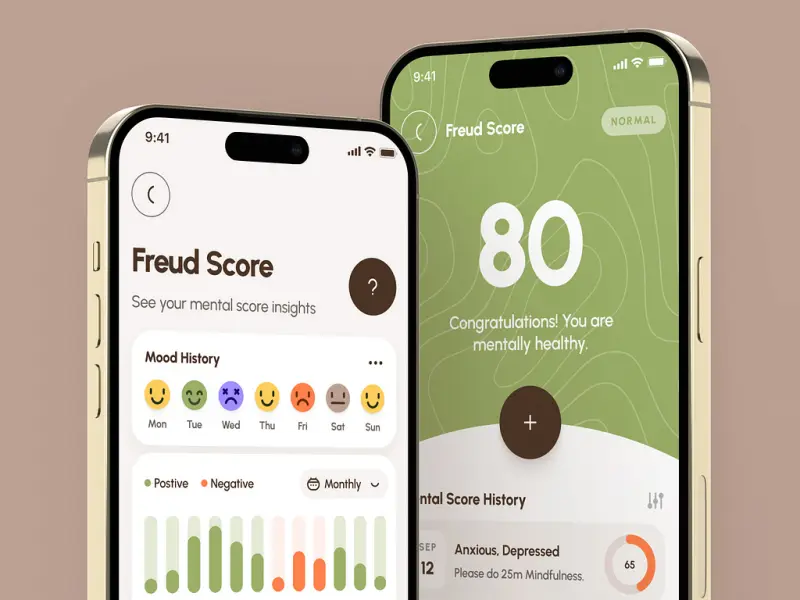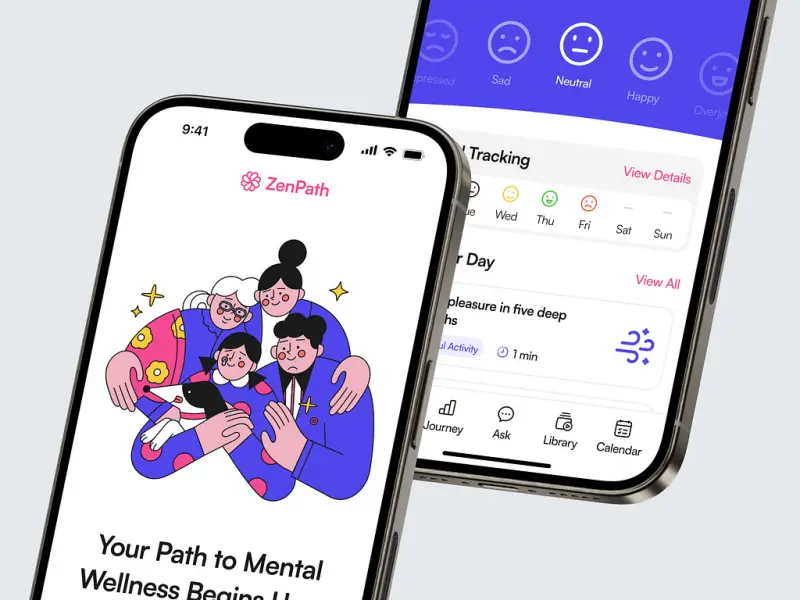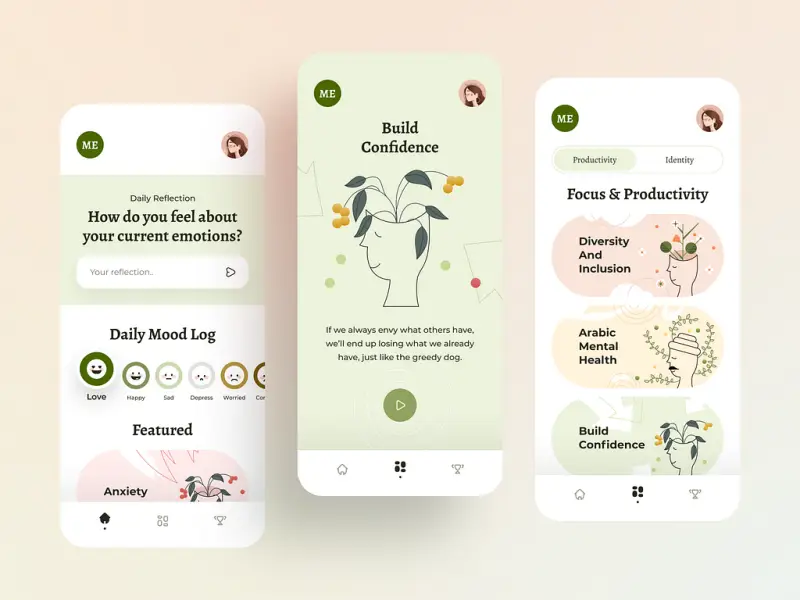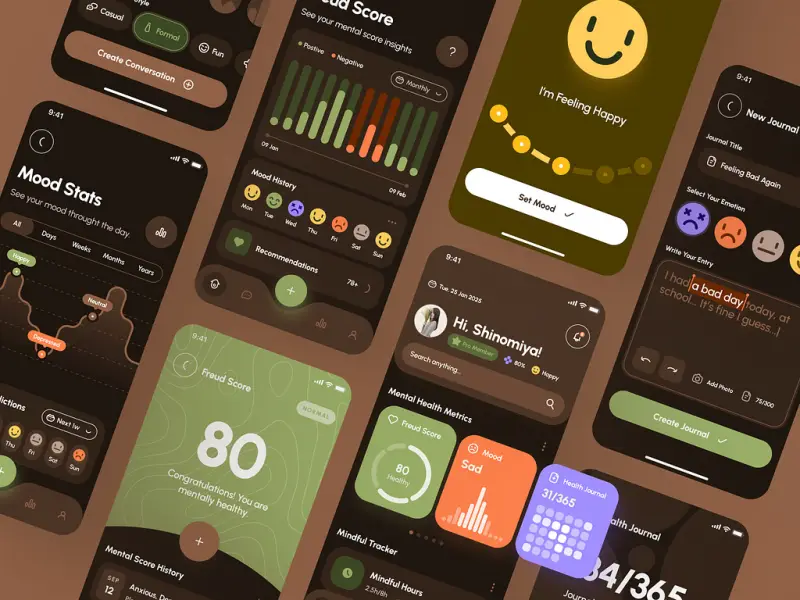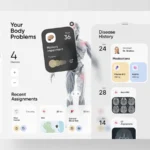Secrets to Successful Mental Health App Development
- TECHVIFY Team
- January 6, 2025
- Knowledge, Guides
- 0 Comments
Mental health app development offers a meaningful opportunity to bring comfort, peace, and balance to countless lives. In an era where mental health challenges are on the rise, these apps are not only tools for change but also gateways to creating a positive impact.
As the demand for mental health app development grows, the market continues to expand. In fact, the U.S. mental health app market is projected to reach $11.73 billion by the end of 2024 and is expected to climb further to $12.02 billion by 2029. This demonstrates both the growing need for and potential profitability from these digital solutions.
In this blog, we’ll explore the types of mental health apps dominating the market, the value they bring, and the steps to create one of your own.
I. Types of Popular Mental Health Apps
Mental health apps cater to a wide range of needs, offering tools to help users manage stress, overcome personal challenges, and foster emotional well-being. Let’s dive into the most common types of mental health apps you can develop:
1. Anxiety, Depression & Mood Control Apps
Mental health conditions like anxiety, depression, and mood swings are increasingly prevalent in today’s fast-paced world. Apps in this category are designed to help individuals manage stress, frustration, and other emotional challenges while increasing their awareness of how these feelings impact the brain.
Creating a mental health app
Key Features:
- Assessment Tests: Preliminary quizzes to gauge symptoms (note: not to replace clinical diagnoses).
- Short Video Calls: Direct communication with mental health specialists.
- Self-Assessment Tools: Journals or questionnaires to track emotions.
- Suicide Prevention Tools: Audio/video distractions to redirect harmful thoughts.
- Emergency Consultancy: Immediate access to professional help and emergency services.
- Progress Trackers: Tools to monitor emotional well-being over time.
By offering these features, apps like these provide users with accessible resources to manage their mental health proactively.
2. Mental Disorder Management Apps
Apps in this category are tailored to support individuals managing specific mental health conditions, such as OCD, bipolar disorder, or PTSD. They often incorporate evidence-based techniques, such as Cognitive Behavioral Therapy (CBT) or positive psychology practices, to empower users in their recovery journey.
Key Features:
- Proven therapy techniques like CBT and ACT (Acceptance and Commitment Therapy).
- Tools for symptom mitigation, early detection, and self-care.
- Mood and behavior tracking to monitor progress and detect warning signs.
- Breathing and anger management exercises to promote mindfulness.
- Direct access to emergency contacts for immediate support.
Specialized apps like ACT Coach and PTSD Coach are great examples of how technology can provide accessible, on-the-go mental health support.
Still want to see more Healthcare articles? Check here:
3. Addiction Recovery Apps
Breaking free from addiction is a significant challenge, and these apps aim to provide the tools and encouragement users need to succeed. From tracking progress to offering community support, addiction recovery apps are valuable companions on the road to recovery.
Key Features:
- Progress Trackers: Visualize milestones, such as achieving a set number of sober days.
- Motivational Notifications: Positive affirmations like “You’re doing great!” or “Keep up the amazing effort!” to boost morale.
- Relapse Prevention Tools: Peer support groups, 24/7 live support, and relapse awareness education.
These apps combine professional techniques and community-driven resources to help users stay committed to their recovery goals.
4. Self-Development Apps
With modern life’s focus on personal growth, self-development apps have become increasingly popular. They help users build resilience, develop new skills, and improve their overall mental and emotional well-being.
Key Features:
- Coaching sessions with professionals via live chats or pre-recorded videos.
- Goal-setting techniques focus on building habits like improved memory, patience, or organization.
- Tools like habit trackers and exercise plans to foster personal growth.
Apps like Happify and Coach.me are examples of platforms that empower users to take charge of their mental and emotional well-being through structured guidance and tools.
5. Meditation and Mindfulness Apps
Meditation apps are among the most popular tools for managing stress and achieving mindfulness. They offer users a way to ground themselves, find moments of calm, and connect with their emotions.
Key Features:
- Guided Meditations: Step-by-step audio or video instructions for beginners and advanced users.
- Breathing Exercises: Simple techniques to reduce stress and anxiety.
- Relaxation Techniques: Soothing music and soundscapes to promote relaxation.
- Sleep Stories: Calming bedtime stories to improve sleep quality.
Apps like Calm and Headspace have successfully introduced millions of users to meditation, making mindfulness an integral part of their daily lives.
6. Multipurpose Apps
For individuals seeking a combination of mental health tools, multipurpose apps are an excellent solution. These platforms often combine telemedicine, therapy, and self-help features into one convenient package.
Key Features:
- Telemedicine Platforms: Access to licensed therapists and psychiatrists via video/audio calls or messaging.
- Customizable Therapy Options: Individual, couple, or family therapy sessions.
- 24/7 Support Options: On-demand chat and messaging for immediate emotional relief.
Apps like BetterHelp and 7 Cups have set the standard for multipurpose mental health platforms, offering comprehensive tools to support users across a variety of emotional and psychological needs.
II. How to Create a Mental Health App: A Step-by-Step Guide
Developing a mental health app isn’t just about coding—it’s about creating a meaningful tool that supports users on their journey to emotional well-being. To succeed, you need thoughtful planning, a clear understanding of your audience, and a user-friendly design. Here’s a step-by-step guide to help you turn your idea into a reality.
Mental health app development guide
Step 1. Identify Your Target Audience
The first step is to understand whom your app is designed for. When creating a mental health app, it’s important to recognize that mental health needs vary greatly depending on age, lifestyle, and cultural background. For example, teenagers may seek tools for emotional expression, while adults might prioritize stress management or therapy options. This is why creating a mental health app tailored to your audience is essential.
Research your audience’s specific needs and challenges. Create a detailed user profile to guide your decisions on app design, features, and even monetization strategies. Knowing your audience helps you design a product that resonates with them and keeps them coming back.
Step 2. Assemble the Right Team
Building a mental health app requires expertise in multiple areas. You’ll need designers to create an intuitive user experience, developers to build a secure and compliant app, and project managers to keep everything on track. If you don’t have an in-house team, consider outsourcing to professionals with experience in healthcare apps.
An experienced team can also help you launch a Minimum Viable Product (MVP)—a simplified version of your app that allows you to test its core features early. This approach saves time and money while offering valuable insights.
Step 3. Prototype and Define Features
Before diving into development, create a prototype to test your app’s design and functionality. A clickable prototype lets you simulate the user experience without writing any code, helping you refine your app’s flow and features early on.
Focus on simplicity and usability. A mental health app should be clean, intuitive, and easy to navigate. Use calming colors, minimal design elements, and straightforward layouts to create a sense of trust and relaxation.
Include features that resonate with your audience, like mood tracking, guided meditations, or journaling tools. Consider motivational push notifications to encourage daily engagement and voice or animated assistants to simplify onboarding.
Step 4. Develop the App
Once your prototype is finalized, it’s time to bring your app to life. This stage involves coding, integrating features, and ensuring the app meets all safety and privacy requirements.
Security is critical, especially if your app collects sensitive health data. Make sure it complies with regulations like HIPAA in the U.S. or GDPR in Europe. Use trusted third-party tools for features like video calls or authentication to save time and ensure reliability.
Adopt an Agile approach to mental health app development by building your app in stages, testing, and refining it with each iteration. This helps you identify and fix issues early while staying on track with your timeline.
Step 5. Test Your App Thoroughly
Testing is essential to ensure your app is functional, secure, and user-friendly. Conduct a variety of tests, including functional, compatibility, usability, and performance testing.
For example, usability testing involves having real users interact with your app to ensure it meets their needs. Security testing, on the other hand, involves checking for vulnerabilities to protect sensitive user data.
By rigorously testing your app during the mental health app development process, you can identify and fix issues, delivering a product users can trust.
Step 6. Launch and Continuously Improve
After testing, it’s time to launch your app. Promote it with a targeted marketing campaign to generate awareness and drive downloads. However, launching is just the beginning.
Use analytics tools to monitor how users interact with your app. Identify which features they use most and where they might be dropping off. This data will help you make improvements and add new features over time.
Regular updates are key to keeping users engaged and ensuring your app stays relevant. A well-maintained app not only retains existing users but also attracts new ones through positive word-of-mouth.
Have a Project Idea in Mind?
Get in touch with experts for a free consultation. We’ll help you decide on next steps, explain how the development process is organized, and provide you with a free project estimate.
III. Key Issues Mental Health Apps Must Address
Developing a mental health app comes with unique challenges. Users rely on these apps for something deeply personal—their emotional well-being. To succeed, mental health app developers must address several critical concerns, from regulatory compliance to user trust. Let’s explore these concerns and how to overcome them effectively.
Problems when creating a mental health app
Follow Regulations
Ensuring your app complies with privacy and security regulations is non-negotiable. People trust mental health apps to keep their sensitive information safe. Failing to meet regulatory standards could not only harm users but also expose your business to legal consequences.
Depending on where your app operates, you must follow specific regulations such as:
- HIPAA (USA): Protects sensitive health information.
- PIPEDA (Canada): Governs personal data protection.
- GDPR (EU): Ensures data privacy and security across Europe.
- UK Privacy and Data Laws: Includes GDPR and the Data Protection Act 2018.
To stay compliant, prioritize user data security from day one, and partner with legal experts who specialize in healthcare apps to ensure adherence to local laws.
Protect User Data
Privacy is at the heart of creating a mental health app. Users need to feel confident that their data is safe from breaches or misuse. Implement robust security measures like:
- Two-Factor Authentication: Adds an extra layer of protection.
- End-to-End Encryption: Safeguards data during transmission.
- 256-bit Encryption: Protects stored information from unauthorized access.
A transparent privacy policy and educating users about how their data is handled will also go a long way in building trust.
Build User Trust
Trust is essential for mental health apps to succeed. Users must feel confident that the app prioritizes their well-being. To build trust:
- Be upfront about how data is collected and used.
- Obtain certifications that demonstrate your app meets high security and clinical standards.
- Partner with mental health experts to ensure your app’s methods and features are credible and effective.
The more transparent and professional your app appears, the more likely users will stick with it.
Use Proven Methods
Creating a mental health app that’s rooted in proven therapeutic techniques is essential. Collaborating with mental health professionals ensures your app delivers real value. Backing features with scientific references or clinical research adds credibility. For example, incorporating evidence-based methods like Cognitive Behavioral Therapy (CBT) or Mindfulness-Based Stress Reduction (MBSR) can make your app more impactful while reassuring users of its legitimacy.
Reduce Stigma
Mental health apps often face the challenge of stigma. Many people hesitate to seek help due to fear of judgment or social consequences. Your app must create a safe, judgment-free environment by:
- Using non-intimidating language and visuals.
- Allowing anonymous use for users who aren’t ready to share personal details.
- Providing resources to normalize seeking help, such as educational content or success stories.
A welcoming and non-judgmental tone can make all the difference in encouraging users to engage with your app.
Learn More On:
IV. Mental Health App Development Best Practices
To create a standout mental health app, it’s essential to follow best practices that enhance usability, trust, and impact.
Mental health app development best practices
Make the Design Simple
Your app’s design is the first thing users notice. It should inspire confidence and provide a seamless experience. Ask yourself:
- Is the onboarding process simple and intuitive?
- Can users immediately understand the app’s purpose and features?
- Does the design follow platform-specific standards, ensuring ease of use?
Avoid overly vibrant or excessively dim designs that might discourage users. Instead, opt for a clean, calming, and accessible interface.
Prioritize Security
While adhering to regulations like HIPAA and GDPR is mandatory, going the extra mile with security measures will give users peace of mind. For example:
- Offer clear explanations of your app’s privacy measures during onboarding.
- Regularly test for vulnerabilities and have a Standard Operating Procedure (SOP) to address security issues swiftly.
- Provide users with tips to protect their accounts, such as creating strong passwords or enabling additional authentication steps.
Support Therapists
Many mental health apps involve therapists or counselors. Providing them with a robust backend system can improve patient outcomes. This might include:
- Dashboards to monitor patient progress.
- Tools to analyze trends in patient data.
- Secure messaging and scheduling systems to streamline communication.
A therapist-friendly interface ensures both sides—patients and providers—benefit from the app.
Work Across Devices
Users often switch between devices like smartphones, tablets, and laptops throughout the day. Your app should offer a consistent experience across all platforms. While this may be challenging to implement from the start, prioritizing cross-platform functionality will make your app more versatile and user-friendly.
Use Wearable Data
Wearables such as fitness trackers and smartwatches can provide valuable data about users’ physical activity, sleep patterns, and heart rates. Incorporating this data into your app can help create a more holistic mental health experience. For example, early detection of irregular activity levels could prompt personalized suggestions for better mental and physical health.
Share Data Securely
Your app should integrate seamlessly with other healthcare systems, such as Electronic Health Records (EHR) or Electronic Medical Records (EMR). This allows for secure, anonymized data sharing with mental health professionals, creating opportunities for partnerships and improved user care.
Be Careful with AI
Artificial Intelligence (AI) can enhance mental health apps, but it must be handled carefully. AI should complement—not replace—human interaction. For instance, chatbots can offer initial support but should include an option to connect users with a live therapist when needed.
AI features must be thoroughly tested to avoid harmful recommendations. For example, there have been cases where poorly trained AI systems suggested inappropriate solutions. Always provide a human fallback option to ensure user safety.
Include Emergency Support
Mental health apps are not substitutes for emergency services. Be clear about this and provide users with appropriate resources for crises, such as suicide prevention hotlines or emergency contact buttons. Avoid offering emergency messaging unless you can guarantee 24/7 human support, as unreliable features can do more harm than good.
Conclusion
Creating a mental health app is more than just a tech project—it’s a chance to make a meaningful impact on people’s lives. By addressing key concerns like security, trust, and usability, and following best practices, you can build an app that stands out, earns user trust, and truly supports mental well-being.
At TECHVIFY, we specialize in mental health app development. Our expert team will guide you through every step—from concept to launch—ensuring your app is secure, user-friendly, and impactful. Contact TECHVIFY today for a free consultation and let’s start building a mental health app that makes a difference.
TECHVIFY – Global AI & Software Solution Company
From Startups to Industry Leaders: TECHVIFY prioritizes results, not just deliverables. Accelerate your time to market and see ROI early with high-performing teams, AI (including GenAI) Software Solutions, and ODC (Offshore Development Center) services.
- Email: [email protected]
- Phone: (+84)24.77762.666




